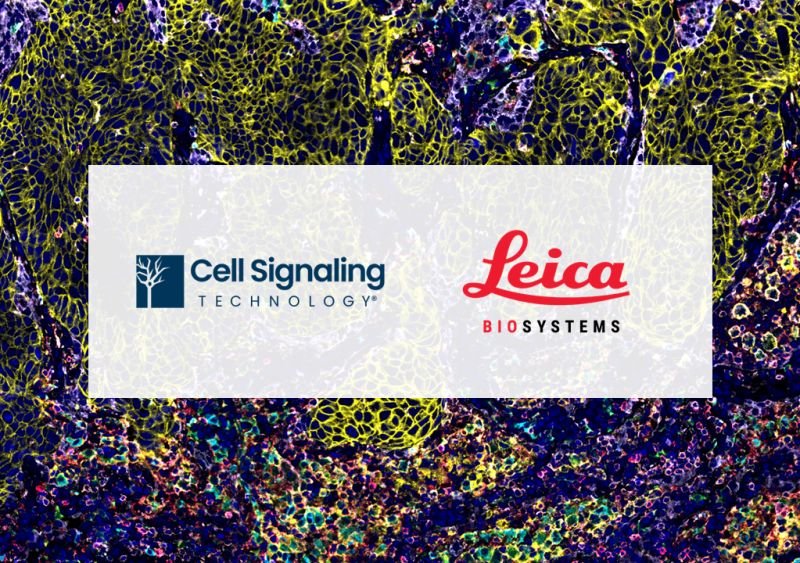Leica Biosystems and Cell Signaling Technology Join Forces to Streamline Spatial Biology Research with SignalStar™ Multiplex IHC on BOND RX
05 November 2024 | Tuesday | News

Fully automated SignalStar™ Multiplex IHC protocol on the BOND RX by Leica Biosystems eliminates hands-on time for streamlined image generation and
Leica Biosystems is pleased to announce a collaboration with Cell Signaling Technology (CST), a life science discovery technology company and leading provider of antibodies, kits, and services, to enable faster, more streamlined spatial biology research on the BOND RX Fully Automated Research Stainer. The partnership significantly reduces hands-on time for scientists leveraging the SignalStar Multiplex IHC assays by enabling easy-to-use, automated BOND RX and BOND RXm protocols to generate 8-plex multiplex IHC (mIHC) images in just two days.
Mid-plex antibody panels enable comprehensive analysis of complex tissue samples and are instrumental for observing colocalization patterns in solid-state tumor research. Above: SignalStar immunohistochemical analysis of paraffin-embedded human squamous cell lung carcinoma using PD-L1 (E1L3N®) & CO-0005-594 SignalStar™ Oligo-Antibody Pair #28249, as well as other SignalStar antibody pairs. Staining was performed on the BOND RX by Leica Biosystems.
The SignalStar mIHC assay is a revolutionary tool for mid-plex spatial biology research that leverages highly validated and customizable, ready-to-go antibody panels and a proprietary technology to amplify antibody signal. With the SignalStar technology, researchers can easily interrogate tissue architecture and biomarker co-expression patterns for up to eight targets in formalin-fixed, paraffin-embedded (FFPE) tissues. The flexible antibody panel design allows targets to be switched out at any time, meaning researchers can easily adjust to changing experimental needs without the need to re-optimize or re-validate antibody panels. Together, the SignalStar technology and BOND RX deliver assay results 70% faster from sample to imaging than other mIHC methods.
“Through this partnership with Leica Biosystems, the powerful SignalStar assay is now more accessible to researchers—even those without a spatial biology background—helping to enable high-throughput multiplexing experiments in rapidly growing areas like immunology and neurology,” says Roberto (Roby) Polakiewicz, PhD, Chief Scientific Officer at CST. “With other mIHC methods, antibody panels can take months to design and optimize and need to be reconfigured if and when experimental needs change. SignalStar now works on the BOND RX out-of-the-box, further reducing time to results, and the flexibility of antibody panel design allows researchers to easily update their assays as research evolves.”
The BOND RX staining platform lets researchers fully automate emerging technologies, customize all protocol segments, and put theories into action. The BOND Covertile protects tissue morphology and enables gentle and consistent reagent application. Together, the BOND Covertile and gentle nature of SignalStar protect samples and enable downstream analysis on the same tissue. Utilizing the BOND RX for multiplexing enables researchers to maximize the data achieved per sample.
Most Read
- How Health Systems Are Reshaping Drug Adoption, Partner Models, and Market Access in 2026
- Top 25 Biotech Innovations Redefining Health And Planet In 2025
- The New AI Gold Rush: Western Pharma’s Billion-Dollar Bet on Chinese Biotech
- Top 25 Biotech & Biopharma Leaders in Sustainable Innovation, 2025
- China’s Biopharma Dealmaking Surges in H1 2025, Driven by Record Licensing and Oncology Focus
- Chikungunya in China: How a “Forgotten” Arbovirus Found the Perfect Storm
- How Innovation Gaps in Biopharma Raise New Safety Concerns
- Smart Implants and the Future of Musculoskeletal Injury Treatment
- How Ethical Gaps in Psychiatry Could Undermine Biopharma Progress
- The Evolving Landscape of Women’s Health Innovation in the Asia-Pacific
- Using NLP-Driven Decision Support in Emergency Health Assistance
- Taiwan Steps Into the Global Spotlight With a New Cancer Therapy
- The Role of Unique Device Identification (UDI) in Tracing Medical Device Safety
- The Importance of a Patient’s Mental Health During Clinical Trials
Bio Jobs
- The State of Biotech and Life Science Jobs in Asia Pacific – 2025
- Avantor’s New CEO Ligner Aims to Unlock Global Potential and Deliver Shareholder Value
- AstraZeneca Commits $50 Billion to U.S. Expansion by 2030 in Biggest-Ever Global Investment
- Thermo Fisher, SAMRC, and South Africa’s Department of Science and Innovation Launch CATIR to Nurture Next-Gen Scientists
- Cube Biotech Appoints Former Sartorius CEO Dr. Joachim Kreuzburg to Board of Directors
- FDA’s AI Transition Marks a Turning Point in Drug Review: Industry Faces Pressure to Adapt Amid 20% Workforce Cut
- WuXi XDC Completes Mechanical Build of Singapore Bioconjugate Manufacturing Hub
News
Editor Picks











